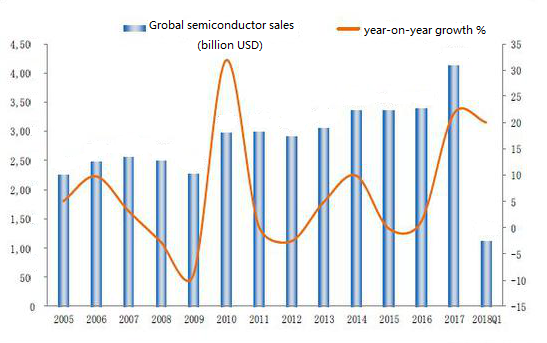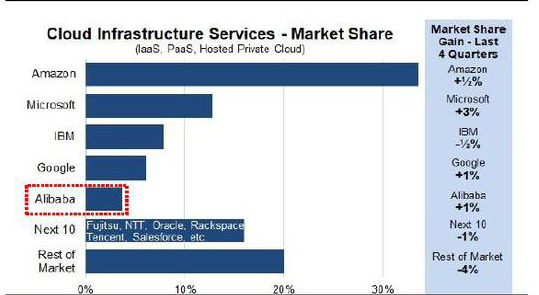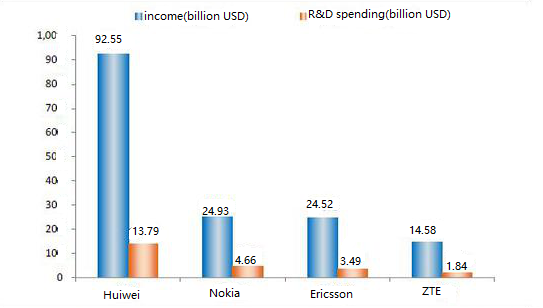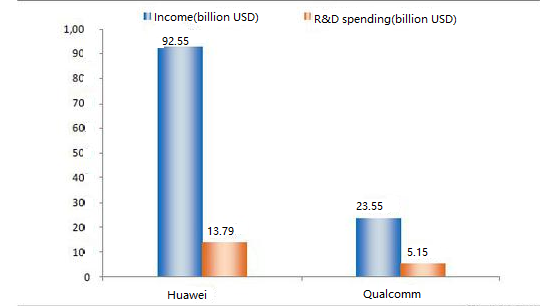4
Introduction
Information and Communication Technology (ICT) is the core technology and important engine of the third industrial revolution. As a versatile technology, information technology is considered to be an important symbol of comprehensive national strength for its obvious extensive effects on other industries and overall economic growth, and its vital role to national security and military strength.
The gross output value of the global ICT industry In 2017 exceeded US$5.2 trillion, of which ICT services reached US$3.45 billion and ICT manufacturing US$1.8 trillion. From the perspective of subdivision, integrated circuits, software and IT services, and communication have become vital parts for enterprises and countries for its functions in information calculation, processing and transmission.
1.1 Semiconductors and Integrated Circuits
The total output value of global semiconductor industry has grown from $132 billion in 1996 to $412.2 billion in 2017. US companies currently account for about half of the global semiconductor market share according to the statistics of the Semiconductor Industry Association (SIA) , followed by South Korea and Japan. China's current market share is only around 5%.

Figure.1 Global semiconductor sales
Semiconductors can be divided into discrete devices, optoelectronics, sensors, and integrated circuits. Integrated circuits accounted for 81.6% ,the highest proportion of the global semiconductor sales in 2016. China has now become the world's largest semiconductors consumer with only 10% self-sufficiency ratio and over 200 billion US dollars in annual import .
China still cannot achieve chip self-sufficiency in many core integrated circuits term such as server MPU, personal computer MPU, FPGA, DSP, etc. The ZTE’s bankruptcy after US’ sanction is caused by its high dependence on suppliers such as Broadcom in high-end optical communication chips, router chips and so on. China’s external dependence reflects its lack of sufficient and long-term R&D input in core industrial chains of integrated circuits. In 2017, US chip giant Intel's R&D spending reached 13 billion US dollars, capital expenditure 12billion US dollars with it R&D spending close to china’s annual revenue in semiconductor industry. Qualcomm, Broadcom, NVIDIA and other chip design manufacturers also planned to spend about 20% of sales revenue in chips research and development. SMIC, the leading manufacturer of integrated circuits in China, has a capital expenditure of US$2.63 billion in 2016 but R&D investment only US$318 million. Therefore, there will be a larger output gap between China and the US in semiconductor industry under such a investment disparity.
As a symbol of the modern precision manufacturing, a small microprocessor integrates billions of transistors and need to go through hundreds of processes, which determines the "short board effect" in the chip field - faults in any part or process may lead to a failure of required yield. Besides, new chips manufacturing required a long-term R&D process that requires not only a large number of professionals, but sufficient supply of key equipment and raw materials.
Among the top ten semiconductor equipment suppliers in the world, except for ASML in the Netherlands and ASM Pacific in Singapore, four are located in the United States and four in Japan, of which the American Applied Materials Company (AMAT) ranked first with its sales reaching up to 10 billion US dollars. The four US companies have already accounted for 50% of the global market, even enter Dutch lithography giant ASML as shareholders, like Intel. However, there are no Chinese enterprises in the list. In 2016, China’s semiconductor equipment sales were only 5.733 billion RMB, of which CLP Electronic Equipment Group ranked first with sales only 908 million RMB. The US AMAT products, leading the world’s semiconductor equipment sales for many years, almost cover all semiconductor equipment such as CVD, PVD, etching and CMP. The company, of which 30% employees are researchers, has owned over 12 thousands patents with annual R&D spending over 1.5 billion US dollars. In contrast, the R & D spending of China’s industrial leader North Huachuang is no more than 100 million US dollars.
From the perspective of the industrial chain, integrated circuits can be divided into three parts: design, manufacturing and packaging testing. The vertical integration mode is also called IDM (Integrated Device Manufacture), represented by Intel and Samsung. The specialized division of labor can be divided into fabless (IC design), casting (wafer foundry), packaging and testing. The core of Fabless is IP, represented by Qualcomm; the core of casting is the advancement and stability of the process, represented by TSMC; while the packaging and testing is relatively less technical than the first two.
In the field of IC design, two Chinese manufacturers marched into the world’s top ten Fabless manufacturers in 2016. Huawei Hisilicon ranked seventh, Ziguang Group ranked tenth, and the total market share was about 7%. Considering Broadcom’s plan to move its headquarters from Singapore to the United States, US companies can occupy 7 seats in the list of the top ten Fabless manufacturers in the world with a total market share of 56%, which reflects US’s leading role in the chip design. What’s more, it would take more shares if we count IDM's Intel.
China has made great progress in the field of IC design in recent years. In 2010, no manufacturer in mainland of china were short-listed in the top ten Fabless manufacturers, except for Taiwan’s MediaTek, which ranked fifth; and the remaining nine were US companies. But in 2016, Huawei HiSilicon and Ziguang Group both entered the top ten, and the global market share of mainland companies in the IC design field has doubled from about 5% in 2010 to about 10%. At the same time, the share of US companies fell from 69% to around 55%. Although it’s difficult to shake US's dominance in the field of IC design in the short term, the gap is narrowing.
In the foundry field, China has two seats in the world's top ten foundries, of which SMIC ranked fourth, Huahong ranked eighth, with a total market share of 7%; while US Global Foundries ranked second with market share reaching 11%. in addition, TSMC is the absolute leader in pure wafer foundry with a market share of 59%.The Sino-US gap does not only lie in the market share, but in the process yield. Hua Hong's highest level of process yield is only 90nm.
Summary: China is the world's largest semiconductors and integrated circuits consumer market, but 90% of its consumption demands are met by imports with it value over 200 billion us dollars. There is a big gap between china and us in capital and R&D investment in the field of integrated circuits. China is weakest in the self-sufficiency of key equipment and materials for semiconductors; and there is still a huge gap in IC design, though china’s Tech giants, like Huawei, HiSilicon, Ziguang and Spreadtrum, have made great progress in recent years. In the manufacturing field, TSMC is strong enough, and SMIC lags far more behind than the world’s most advanced process technology.
1.2 Software and Internet Services
By the function classification, the software can be divided into system software, supporting software and application software; wherein the system software is responsible for managing and scheduling various hardware resources and programs, the application software is responsible for implementing specific functions for specific domains and the supporting software is located between the two, responsible for support the writing and maintenance of other software, such as programming software, database management software, etc. Most of the current Internet services are actually equivalent to application software.
According to the “2017 Top 1000 List of Global Innovative Enterprises” published by PricewaterhouseCoopers, China’s BAT advanced into the top ten in terms of R&D investment, ranking 7th, 8th and 10th respectively. While the top five are all American companies - Amazon, Google, Microsoft, Oracle, Facebook. Amazon, Google, and Microsoft, the top three US software and Internet service companies, have spent more than $10 billion in research and development, but the big brother Alibaba in BAT has only $2.5 billion as its R&D spending.
If Internet service companies are not included, all the top 10 software innovation companies are from the U.S, except Germany's SAP, while not a single Chinese companies is on the list. Kingsoft, the top-ranked innovation in China's software industry, invested $260 million in research and development in 2017, compared with which, Microsoft spent $1.199 billion on R&D.
In the field of system software, the current PC operating system is basically monopolized by Windows. The installed capacity of Windows is close to 88% of the overall market’s, even over 97%, if estimated with Mac OS. The mobile operating system is occupied by IOS and Android with more than 98% market share. Besides, Oracle is the exclusive leader in mastering database system. In the field of basic software and underlying systems, China is still a beginner.
Operating system development, as a system engineering, is a huge project. There are about 23 groups, over thousands talents, in the Windows 7 development team that need to write more than 50 million lines of code; therefore, system development will be bound to be inefficient if lacking R&D spending. Most current operating system R&D of China is based on the Linux open source kernel for its secondary use; and it is believed that the technical problems can be solved, and the political and military autonomous controllable needs can also be met if China strive for. But it’s not possible currently for china to apply it to short-term commercial use because operating system development does not meet the logic of commercial input-output ratio.
The underlying operating systems such as Windows, IOS, and Android are equivalent to the foundation of the building. On this basis, a mature ecosystem has formed, in which the application library and the developer community interact, promote and depend on each other. If there is no revolutionary experience change, developing again is equivalent to rebuilding a building with the input and output not proportional. Therefore, commercial companies are rarely involved, and it is more suitable for universities and scientific research institutions to conduct R&D as academic project.
Cloud computing is actually the system management and deployment of computing, storage and network resources and applications on the Internet. According to the service forms, cloud computing can be mainly divided into three categories: IaaS(Infrastructure-as-a-Service), PaaS(Platform-as-a-Service), SaaS (Software as a Service); among them, IaaS and PaaS manage the lowest-level hardware resources and basic applications (such as databases), so also being regarded as the infrastructure of the next generation information society.

Figure.2 The market share of global infrastructure cloud service in 2017
According to statistics from the US market research firm Synergy Research, Amazon's AWS market share is close to 35% in the global infrastructure cloud service (IaaS+PaaS+ hosted private cloud) market. The rest are Microsoft Azure, IBM, Google, and Alibaba Cloud whose global market share is less than 5%.
In the field of SaaS, Microsoft surpassed Salesforce to become the number one after acquiring LinkedIn. The remaining top rankings of Adobe, Oracle and SAP are also leading companies in the traditional software field. China has no representative enterprise due to its weakness in the traditional software field.
Summary: China is quite weak in the software field, especially in the field of system software and supporting software. In the field of Internet services, BAT can compete with Amazon, Google, and Facebook, but far more behind than the US counterparts in research and development. The same to the field of cloud computing, Alibaba Cloud has developed rapidly, but the current volume is only 1/10 of that of Amazon AWS.
1.3 Communication
Communication is the "neural network" of the information society. At present, in the world's four major communications equipment giants Huawei, Ericsson, Nokia, and ZTE, China ranks the second. Huawei's 2017 sales were US$92.55 billion, and R&D investment US$13.79 billion, significantly surpassing traditional communications equipment giants Ericsson and Nokia. Compared with the US wireless communications giant Qualcomm, Huawei's revenue and R&D spending are also leading the way. In the past ten years, Huawei has invested nearly 400 billion yuan in research and development with more than 70,000 patents currently(more than 90% are invention patents).

Figure.3 Four Global communication equipment giants

Figure.4 The comparison between Huawei and Qualcomm
Starting from the agent switch, then establishing Haisi Semiconductor to conduct independent research and development of integrated circuits in 2004, Huawei has become the world's leading communication equipment supplier through 30 years of efforts; and on this basis, it has entered the enterprise-class core router and mobile terminal market. According to the data from a market research organization IDC, Huawei's Ethernet switch market share reached 8.1% in the first quarter of 2018, and enterprise-class router market share reached 25.1%, second only to Cisco; in the mobile terminal market, Huawei's smartphone shipments exceeded 130 million in 2016, following closely to Apple and Samsung.
In the standard formulation of the next-generation communication technology 5G , Chinese companies represented by Huawei have also begun to play its role. 3GPP defines three major application scenarios for 5G: eMBB (high-traffic mobile broadband services such as 3D/Ultra HD video), mMTC (large-scale Internet of Things services), and URLLC (delay communication business on unmanned and industrial automation and so on). In the 3GPP RAN1#87 conference held in Reno, USA in November 2017, Huawei-led Polar code became the final scheme of control channel coding in the eMBB scenario, and Qualcomm-led LDPC code became the digital channel coding scheme, showing China and the United States is well-matched in strength. This is also the first time that the channel coding standard as a communication physical layer technology has been promoted by Chinese companies, representing that China's strength in the global communications field has been improved.
In terms of 5G chips, Huawei, in February this year, released the world's first 5G commercial baseband chip Baron 5G01 of 3GPP standard at the 2018 World Mobile Congress (MWC), which can provide 2.3Gbps transmission speed, support high and low frequency, and also support independent or Non-independent mode networking. Besides, Huawei is also the first 5G solution provider with “5G chip-terminal-network capability”. In the national 5G test project, Huawei exceeded Ericsson, Nokia Bell and other manufacturers in the second phase, taking the lead in completing all tests and advancing in its performance indicators such as cell capacity and network delay.
Although it has become the number one in the global communications industry, Huawei has a clearer understanding of the past than ordinary people. Huawei founder Ren Zhengfei said at the 2016 National Science and Technology Innovation Conference that as the Shannon's theorem and Moore's Law don’t work out, Huawei is planning to take a venture by doing something new, which reflects the decline of "herd doctrine". How to transfer from engineering mathematics, physical algorithms and other engineering science innovations to major basic theoretical innovations? how to become a leader instead of a follower? They are not the questions only Huawei faces. To ensure long-term competitiveness and leadership in the field of science and technology, soft power such as education system, science and technology system, and innovation environment are equally important.
You May Also Like:
New Materials Selection Has Been An Trend
Common Guider for Selecting Electronic Components
List of Integrated Circuit Packaging Types
Why do Internet Giants Want to Self-develop Chips?
Ordering & Quality
| Photo | Mfr. Part # | Company | Description | Package | Qty |
|
MMA8451QR1 | Company:Freescale Semiconductor - NXP | Remark:ACCELEROMETER 2-8G I2C 16QFN | Package:QFN |
MMA8451QR1 Datasheet |
In Stock:25194 Inquiry |
Inquiry |
|
MC9S08PT32VLC | Company:NXP | Remark:IC MCU 8BIT 32KB FLASH 32LQFP | Package:32-LQFP |
MC9S08PT32VLC Datasheet |
In Stock:103 Inquiry |
Inquiry |
|
MPY100CM | Company:TI | Remark:low cost precision device designed for general purpose application | Package:TO100 |
MPY100CM Datasheet |
In Stock:71 Inquiry |
Inquiry |
|
P89LPC9361FDH518 | Company:NXP | Remark:P89LPC9361FDH518, NXP, Embedded - Microcontrollers | Package:28-TSSOP (0.173", 4.40mm Width) |
P89LPC9361FDH518 Datasheet |
In Stock:118 Inquiry |
Inquiry |
|
TMS320DM8127SCYED3 | Company:Texas Instruments | Remark:IC DGTL MEDIA PROCESSOR | Package:684-BFBGA, FCBGA |
TMS320DM8127SCYED3 Datasheet |
In Stock:433 Inquiry |
Inquiry |
|
RL7520WS-R10-F | Company:Susumu | Remark:RES SMD 0.1 OHM 2W 3008 WIDE | Package:Wide 3008 (2075 Metric), 0830 |
RL7520WS-R10-F Datasheet |
In Stock:19360 Inquiry |
Inquiry |
|
MCIMX6U7CVM08AC | Company:NXP / Freescale | Remark:IC MPU I.MX6DL 800MHZ 624MAPBGA | Package:624-LFBGA |
MCIMX6U7CVM08AC Datasheet |
In Stock:95 Inquiry |
Inquiry |
|
A3P030-1QNG48I | Company:Microsemi | Remark:IC FPGA 34 I/O 48QFN | Package:48-VFQFN Exposed Pad |
A3P030-1QNG48I Datasheet |
In Stock:146 Inquiry |
Inquiry |
|
MC9S08GT16CFBE | Company:NXP / Freescale | Remark:IC MCU 8BIT 16KB FLASH 44QFP | Package:44-QFP |
MC9S08GT16CFBE Datasheet |
In Stock:16320 Inquiry |
Inquiry |
|
TMMBAT46FILM | Company:STMicroelectronics | Remark:DIODE SCHOTTKY 100V 150MA MINMLF | Package:DO-213AA (Glass) |
TMMBAT46FILM Datasheet |
In Stock:48488 Inquiry |
Inquiry |